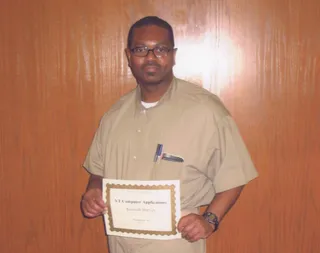A Living Death: Faces of Those Sentenced to Life for Non-Violent Crimes
Thousands are serving life for petty crimes in America.

1 / 11
A Startling Statistic - More than 3,200 people are serving life without parole for nonviolent crimes, according to a new report by the American Civil Liberties Union. More than 60 percent of those prisoners are African-American, the organization estimates. Here are the faces and names of several men and women who have been given severe punishment, required by the law. — Natelege Whaley(Photo: Doug Berry/Getty Images)

2 / 11
Clarence Aaron - At 23, Clarence Aaron, who was in his last year of college at Southern University in Baton Rouge, Louisiana, was given three life-without-parole sentences in 1993. He introduced a college classmate to a cocaine dealer. Aaron arranged for transportation of the cocaine and was present in the sale of it. He was paid $1,500 for his involvement. He was convicted for conspiracy to possess with intent to distribute crack cocaine. (Photo: Courtesy of ACLU)

3 / 11
Sharanda Purlette-Jones - Sharanda Purlette-Jones was convicted of six counts of crack cocaine possession based on the testimony by five co-conspirators in Texas in 1999. She was arrested after a couple acting as government informants asked her where she could buy drugs. Other than the taped phone call, there was no evidence that she was involved in drug-trafficking in Houston. Her family members were also arrested. She had no prior criminal record. (Photo: Courtesy of ACLU)

4 / 11
Timothy Jackson - In 1996, Timothy Jackson was arrested for shoplifting from a department store in New Orleans. He put the jacket down outside of the store after realizing he was being followed. Instead of the court convicting him for the two-year sentence his crime carried, he was given mandatory life without parole under Louisiana’s four-strike law. A past juvenile conviction and two car-burglary convictions were used against him. (Photo: Courtesy of ACLU)

5 / 11
Paul Carter - At an early age, Paul Carter began using drugs and struggled with heroin addiction. He was sentenced to life in prison because a trace of heroin residue was found on him in 1998. The amount was so small, “it could not be weighed.” He was convicted under Louisiana’s three-strike law. He was charged with simple escape in 1987 and for possession of stolen property in 1991, crimes that were counted in deciding his sentence. (Photo: Courtesy of ACLU)
ADVERTISEMENT

6 / 11
Hershel Miles Jr. - Because Hershel Miles Jr. had served time in prison for selling cocaine and for burglary, he was given a life sentence after he was convicted of petit larceny. In 2001 he attempted to cash a stolen check he received as payment from a man who was paying him for a motor. He has served 11 years in prison, with no option for parole, since the conviction. (Photo: Courtesy of ACLU)

7 / 11
Danielle Metz - Danielle Metz, who was in an abusive marriage, was given a life sentence in 1993 for being part of her husband’s cocaine distribution enterprise. She had been involved with transporting money and cocaine from Houston to New Orleans. Metz soon left her husband after he gave her a bloody nose. Two months later, she was indicted for her involvement in his drug ring. She had no prior offenses and 11 white middle-aged jurors and one Black juror decided her fate. (Photo: Courtesy of ACLU)

8 / 11
Michael Fitzgerald Wilson - Michael Fitzgerald Wilson was sentenced to life in jail without parole in 1993 as a first-time, non-violent drug offender. He and his brother, who owned a car dealership in Dallas, were charged with being involved in a crack cocaine conspiracy, although no drugs were found in his home or business. (Photo: Courtesy of ACLU)

9 / 11
Donald Allen - At 20, Donald Allen had a history of selling crack cocaine, but it was his presence during a drug deal in his truck that sent him to jail for life. The court found him guilty of possession of crack cocaine with intent to distribute, and conspiracy to possess with intent to distribute 421 grams of crack in 1998. His brother-in-law received a sentence reduction for his testimony about Allen’s involvement. (Photo: Courtesy of ACLU)

10 / 11
Stephanie Yvette George - As a struggling mother of two, Stephanie Yvette George, who was 23 at the time, got involved in selling drugs with several boyfriends who were drug dealers. During a search, police found a safe in her home that held 500 grams of crack cocaine that her boyfriend hid there. Although she said she had no idea it was stored there, she was still sent to prison for life in 1993. (Photo: Courtesy of ACLU)
